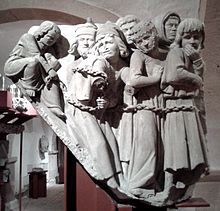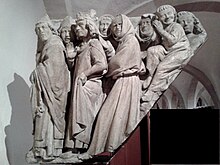The damned in chains
The Damned in Chains are relief sculptures from the west of the Mainz Cathedral . Supplemented by the procession of the blessed , they show a representation of the Last Judgment with a Deesis . The work, created around 1240, is one of the most important of the Gothic and is attributed to an unknown artist, the so-called Naumburg Master . The fragments of the Westlettner, which had other figurative representations, survived its demolition in 1682 and are now kept in the Mainz Cathedral and Diocesan Museum.
The sculptures
The Damned in Chains is the right of the three reliefs in the gable of the central portal of the Westlettner , the figurative program of which focuses on the Last Judgment . A so-called Deesis is shown : the center marks Christ as the enthroned judge of the world - flanked by the kneeling intercessors, Mary and John the Baptist. To the right and left of the pediment were the other two reliefs. On the left they show the group of the blessed who are being led into paradise and on the right the sinners condemned in hell. The remains of the fragments are made of sandstone in the original color. The dimensions of the reliefs are approximately: H. 90 cm; B. 114 cm. A preserved painting is extremely rare in early Gothic sculpture and in this case can only be explained by the comparatively early demolition of the rood screen.
The selection of the blessed and the damned corresponds to the social order of the Middle Ages: The group of the blessed begins with the Pope and his conical tiara , followed by a bishop with miter , then the crowned emperor, nuns and monks and a laughing boy, representing the "innocent Child ”. In the depiction of the damned from the outset intended for hell, according to medieval beliefs, the Jews, whose representatives can be recognized by the characteristic pointed hat (Jewish hat ). Another, armless figure may have represented a miser. A fashionably dressed woman follows who is guilty of the mortal sin of vanity. The monk shows that the clergy are not immune from sin either. They are all pulled by a devil on a chain - which has been added today - into the now lost jaws of hell.
The western latin of Mainz Cathedral
The west lettuce of Mainz Cathedral is only preserved in fragments today. The Mainz Cathedral and Diocesan Museum houses these fragments of the former rood screen. The so-called Naumburg master created the rood screen around 1240, which, as the west choir barrier, separated the area reserved for the clergy from the area of the lay people in the nave. The Mainz rood screen was a three-winged system with large portals opening towards the nave. The rood screen was torn down in the 17th century. Some figurative parts were reused elsewhere, but most of the fragments ended up in the foundations of the newly built, baroque chorets . Several of these fragments were found during construction work in 1925/28. In addition to the Deesis with the procession of the blessed and the damned, the Gothic West Lettner also showed a representation of the resurrection of the dead at the Last Judgment, which is referred to in many places in the Bible. Probably the most famous fragment of the former Westlettner is the so-called head with the bandage. This may be due to his expressively suffering facial expression, which has always captivated the viewer in a special way. The style and shape, image content and image of the rood screen were so innovative that they were repeatedly used as models up until around 1300, for example for the rood screen in the Marienkirche in Gelnhausen, which is still preserved today, or the figures from the portal of the Mainzer Liebfrauenkirche .
The Naumburg master
The Naumburg master brings the latest French forms with him to Mainz, knowledge of which he had acquired on the building sites of the great French cathedrals in Noyen, Metz and above all in Reims. After the Mainz commission, which must have taken several years, the master and his workshop worked on the castle chapel in Iben before setting off to the east to create his main work, which gave him his current emergency name: rood screen and donor figures in the choir of the Naumburg Cathedral .
World judgment representations
→ See also the main article Last Judgment
As an image composition for a depiction of the Last Judgment , it takes centuries to create. The most important components are as follows: Either it contains the enthroned Christ in the clouds, sword and lily that emerge from the mouth of the world judge, the twelve apostles as assessors, angels blowing trumpets, opening graves, the scales on which the Archangel Michael weighs the souls of the risen, paradise and hell's jaws.
Another common picture of judgment is found in Deesis: this group with Mary, the apostles and John the Baptist appearing as intercessors for humanity before the throne of Christ, is part of every representation of the Majesty of the Last Judgment in Western Europe . Sometimes the representations are arranged in two registers: at the top there is the enthroned Christ, usually in the mandorla with a cross in his hand, next to him angels and apostles, often also Mary and John the Baptist. In the lower zone, angels blow the Last Judgment trumpet and raise the dead from their graves. The blessed and the damned usually form two groups on the right and left in the corner of the picture. The figure of the world judge can also be associated with the four beings of the apocalypse - bull, lion, eagle, human being.
Since the 11th century, the motif has also been used in monumental painting, usually in several zones with Christ as the central figure. The damned are often met by devils who thrust them into the jaws of hell. At the end of the Middle Ages and the Renaissance, the sword and a lily emerged from the mouth of Christ. His upper body is mostly bare, he points to his wound on the side. Similar to Die Verdammten from Mainz, the group Der Verdammten from the portal of Bamberg Cathedral is a sculptural part of a depiction of the Last Judgment.
In the interiors of churches, depictions of the Last Judgment are usually on the west side.
iconography
The depiction of the blessed and the damned is a motif from the Last Judgment cycle , the great eschatological final judgment already sketched out in some passages of the Old Testament , in which, according to Christian ideas, Christ as judge of the world judges the living and the dead at the end of the day.
Function in the Middle Ages
A representation of world history leading to the Last Judgment or the divorce of all human beings by the judging Christ, often offers a targeted image of terror. People tormented by demons in the eternal fire are a continuous motif of the depictions of judgment and hell, going back to the end-time parables of the Gospels and the Apocalypse . Comparisons of images show that the representations of the end times in the Middle Ages are not particularly different. They are mostly depictions of feelings such as fear, horror, pain, horror, despair or agony. The aim of the representations could thus be the emotional transmission to the viewer. A cathartic function is assumed to be the aim and purpose of the almost identical, cruel representations. The aim of looking at them is to act out inner conflicts and thus reduce them. The goal of depicting horror is the contritio in the sacrament of penance: there is a connection between depictions of horror and institutions in which people can influence their fate under the guidance of the Church. The central institution to which the judgments relate is the sacrament of penance . There are 3 essential components of repentance:
- contritio cordis - the contrition of the heart
- confessio oris - the confession of the mouth
- satisfactio operis - the satisfaction from the work
So there is repentance when a person is no longer in the state in which he finds pleasure in his deed, as at the time of committing sin, but in a state of inner turning away from what he has done. One can therefore speak of a guilty conscience here. These remorse are often associated with shame and trigger downright despair in the sinner. The state of contritio is by no means a matter of course, but occurs when certain triggers take effect. We're talking about six different triggers:
- Concerns of life
- Shame about the act committed
- Disapproval of sin
- Fear of judgment day
- Fear of hell punishment
- Pain over losing the heavenly fatherland or turning away from God
It is believed that the sacrament of penance was the reference point for the many depictions of judgment and hell in the Middle Ages. The pictures mostly show hell on the one hand and bliss on the other, because this can cause contritio .
literature
- Hans-Jürgen Kotzur (Ed.): Cathedral Museum Mainz. Guide to the collection. Mainz 2008, pp. 28-33.
- Barbara Non-White (Ed.): Lebendiger Dom. St. Martin zu Mainz in the past and present. Mainz 1998, pp. 89-93.
- Notger Slenczka : The ultimate horror. The Last Judgment and Fear in Medieval Religion. In: Das Mittelalter, Vol. 12, 1 (2007), pp. 97–112.
Individual evidence
- ↑ Kotzur; Pp. 28-31
- ↑ non-white; P. 91
- ↑ Kotzur; Pp. 28-33
- ↑ non-white; P. 89
- ↑ Last Judgment Representations ( page no longer available , search in web archives ) Info: The link was automatically marked as defective. Please check the link according to the instructions and then remove this notice.
- ^ Image from the Bamberg portal
- ↑ Slenczka; Pp. 97-100


